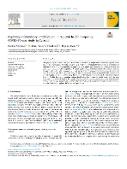| dc.contributor.author | Netrdová, Pavlína | |
| dc.contributor.author | Hulíková Tesárková, Klára | |
| dc.contributor.author | Dzúrová, Dagmar | |
| dc.date.accessioned | 2025-03-13T11:15:29Z | |
| dc.date.available | 2025-03-13T11:15:29Z | |
| dc.date.issued | 2025 | |
| dc.identifier.uri | https://hdl.handle.net/20.500.14178/3033 | |
| dc.description.abstract | This paper proposes a novel conceptual framework of vulnerability amplification to examine regional health inequalities. It combines differential vulnerability in health and social amplification of risk, as mechanisms of differential vulnerability are shaped by mechanisms of social amplification and mutually influence the level and dynamics of regional health inequalities. A spatial epidemiology analytical framework is used to examine ecological and spatial interdependencies, as well as the effects of compositional (population structure) and contextual factors (health intervention), alongside the spatiotemporal effects on regional health outcomes. An empirical application of the concept using the example of the COVID-19 pandemic crisis at the micro-regional level in Czechia documents widening regional health disparities during the health crisis, with the most vulnerable regions most affected. In the case of a possible future health crisis, this conceptual and methodological approach can enhance management of impacts through effective, better-targeted preventive measures that account for fundamental regional differences and specificities. | en |
| dc.language.iso | en | |
| dc.relation.url | https://doi.org/10.1016/j.apgeog.2025.103565 | |
| dc.rights | Creative Commons Uveďte původ 4.0 International | cs |
| dc.rights | Creative Commons Attribution 4.0 International | en |
| dc.title | Exploring vulnerability amplification in regional health inequality: COVID-19 case study in Czechia | en |
| dcterms.accessRights | openAccess | |
| dcterms.license | https://creativecommons.org/licenses/by/4.0/legalcode | |
| dc.date.updated | 2025-03-13T11:15:29Z | |
| dc.subject.keyword | regional health inequality | en |
| dc.subject.keyword | differential vulnerability | en |
| dc.subject.keyword | vulnerability amplification | en |
| dc.subject.keyword | spatial analysis | en |
| dc.subject.keyword | COVID-19 | en |
| dc.subject.keyword | health crisis | en |
| dc.subject.keyword | Czechia | en |
| dc.identifier.eissn | 1873-7730 | |
| dc.relation.fundingReference | info:eu-repo/grantAgreement/MSM//LX22NPO5101 | |
| dc.relation.fundingReference | info:eu-repo/grantAgreement/UK/COOP/COOP | |
| dc.date.embargoStartDate | 2025-03-13 | |
| dc.type.obd | 73 | |
| dc.type.version | info:eu-repo/semantics/publishedVersion | |
| dc.identifier.doi | 10.1016/j.apgeog.2025.103565 | |
| dc.identifier.utWos | 001435330200001 | |
| dc.identifier.eidScopus | 2-s2.0-85218255262 | |
| dc.identifier.obd | 663481 | |
| dc.subject.rivPrimary | 50000::50700::50701 | |
| dc.subject.rivSecondary | 50000::50400::50402 | |
| dc.subject.rivSecondary | 30000::30300::30304 | |
| dc.relation.datasetUrl | https://doi.org/10.17605/OSF.IO/XB923 | |
| dcterms.isPartOf.name | Applied Geography | |
| dcterms.isPartOf.issn | 0143-6228 | |
| dcterms.isPartOf.journalYear | 2025 | |
| dcterms.isPartOf.journalVolume | 177 | |
| dcterms.isPartOf.journalIssue | April 2025 | |
| uk.faculty.primaryId | 115 | |
| uk.faculty.primaryName | Přírodovědecká fakulta | cs |
| uk.faculty.primaryName | Faculty of Science | en |
| uk.department.primaryId | 1056 | |
| uk.department.primaryName | Katedra sociální geografie a regionálního rozvoje | cs |
| uk.department.primaryName | Department of Social Geography and Regional Development | en |
| uk.department.secondaryId | 1057 | |
| uk.department.secondaryName | Katedra demografie a geodemografie | cs |
| uk.department.secondaryName | Department of Demography and Geodemography | en |
| dc.type.obdHierarchyCs | ČLÁNEK V ČASOPISU::článek v časopisu::původní článek | cs |
| dc.type.obdHierarchyEn | JOURNAL ARTICLE::journal article::original article | en |
| dc.type.obdHierarchyCode | 73::152::206 | en |
| uk.displayTitle | Exploring vulnerability amplification in regional health inequality: COVID-19 case study in Czechia | en |

